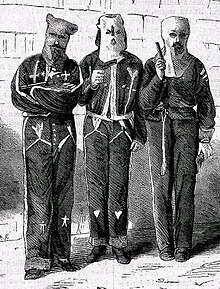Hood
A hood (from Italian : cappuccio : "little coats", to Latin : cappa and Middle High German : cap : "coat with head covering") is a head covering or hood that is usually attached to another, larger piece of clothing, covering the head, the neck and in part should also protect the face and shoulders from cold, wind and rain, and if necessary also from prying eyes. The hood can be part of a traditional costume , a religious vestment , or an official costume (in the Anglo-Saxon area especially in the university environment) or simply a fashion accessory . Usually you let them hang loosely on your shoulders when not in use and only pull them back over your head when necessary.
development
The term hood only appeared in German around 1500. Previously, similar headgear was known under the name Gugel or Zipfel .
Hoods that were sewn onto larger capes , throws or skirts have been known since the Bronze Age . In addition, separate hoods were also common, such as the Phrygian cap of the ancient Persians , Parthians and Scythians . There was a fluent line between items of clothing that would be referred to today as hoods, hats or caps. Such separate hoods often had a more or less long shoulder and neck protection that was closed or lockable at the front. The Celts called such hoods kūkka , which were adopted by the Romans as cucullus . As early as the 1st century AD there are depictions of the Genius cucullatus , a dwarf Gallic guardian spirit with a hooded cloak. Other ancient garments that were often hooded were the sagum cucullatum and the paenula of the Roman legionaries, as well as the caracalla .
In the course of the Middle Ages, the cucullus developed into the Gugel , a hood with more or less long shoulder protection and an extended hood tip. At first it was the common work clothes of the rural population and miners , but in the 14th century gugel made of precious fabrics and sometimes with extremely long lace (the sending band) came into fashion in the higher social classes. A wide variety of wearing styles, cuts and accessories resulted in complex hat, cap or turban-like headgear, such as the chaperon . After these went out of fashion, more extravagant forms of the cowl (e.g. with two or more tips) were retained in the fool's cap .
In the 15th century the collar was separated from the Gugel and developed into a separate item of clothing, the Goller . The pointed cap , on the other hand, was created from the separate head section . In addition, hoods made of soft, thin fabric were worn as additional protection, even under hats .
The Capuchins , a Catholic mendicant order that goes back to Francis of Assisi , are named after the hood of their habit . Since the 16th century, the coats of Spanish nobles and courtiers in particular were provided with a hood, so that they were known in Germany as Spanish caps , but they were not particularly popular. Garments like the roquelor , the calash , the rain cape and others go back to such hooded coats and capes .

Hoods are occasionally worn to make the wearer unrecognizable (e.g. during parades or prisoners), to humiliate him (e.g. convicts), but also to avoid prosecution or in the context of some sexual practices .
At many universities in Great Britain, the USA and the Commonwealth, hoods and hooded cloaks are still traditional clothing that is worn on certain festive occasions (graduation etc.).
present
Since the 19th century, hoods have almost always been firmly attached to a larger item of clothing, such as B. a coat, anorak or a duffle coat . They can be provided with ribbon or a cord for lacing. In raincoats the hood is sometimes removable, or it may be rolled up and stowed in a special pocket in the collar. It is rarely completely separated from the rest of the clothing (see: Southwest ). Even modern diving suits are often equipped with hoods or hoods to reduce the diver's cooling down.
Since the end of the 20th century, pullovers have occasionally been equipped with hoods ( hooded sweaters , also called hooded sweatshirts, hooded sweatshirts or hooded sweatshirts). Together with hoodies and other headgear, they can be found as a fashion accessory in hip-hop youth culture .
See also
literature
Ingrid Loschek : Reclam's fashion and costume lexicon , article “Hood”, 5th, exp. Ed., Reclam, Stuttgart 2005, ISBN 3-15-010577-3 .
Web links
- Description of hoods common today. Retrieved October 29, 2009 .

